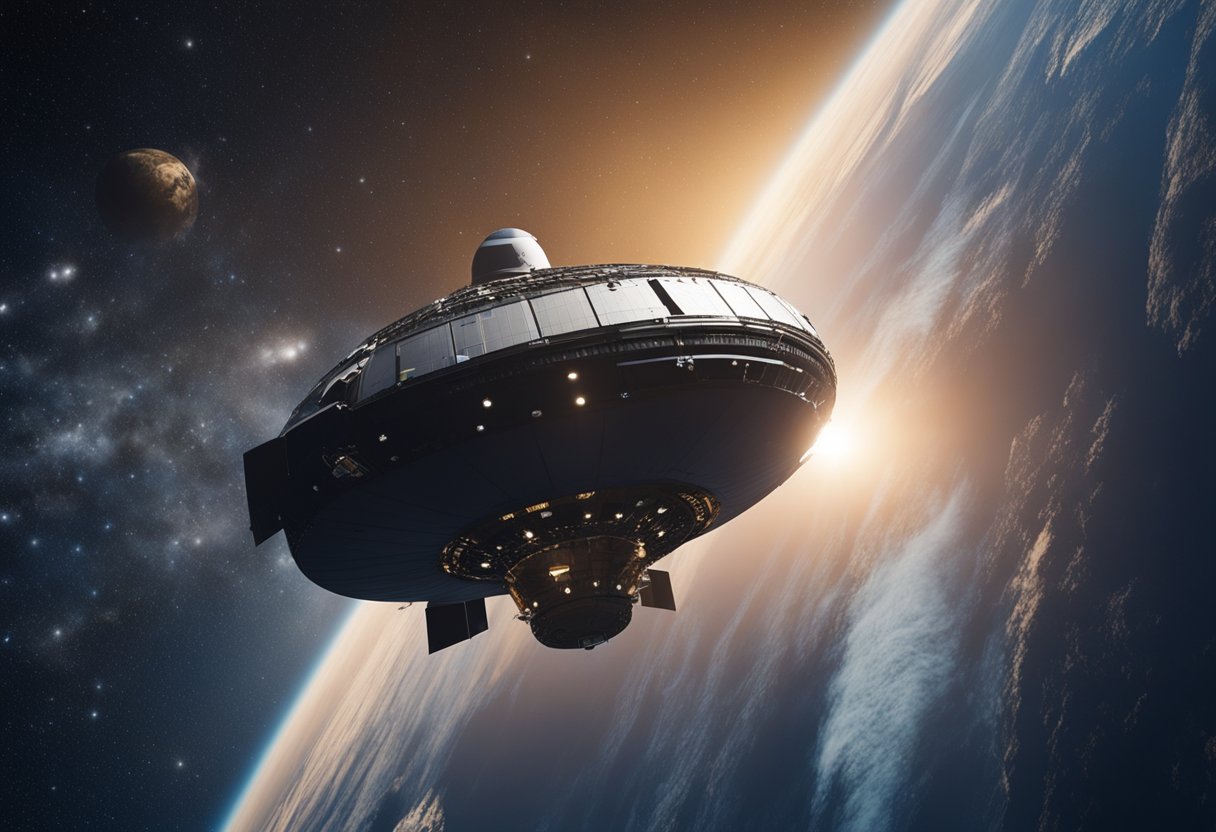
Spacecraft re-entry dynamics encompass the physical and technological challenges involved when a vehicle returns to Earth from space. Re-entry begins when a spacecraft leaves its stable orbit and enters the Earth’s atmosphere, a phase which is meticulously controlled through a balance of speed, angle, and atmospheric drag. Understanding the physics of re-entry dynamics is crucial, as it informs the design and navigation of the re-entering vehicle to ensure that it can withstand the intense heat and forces encountered during this process.
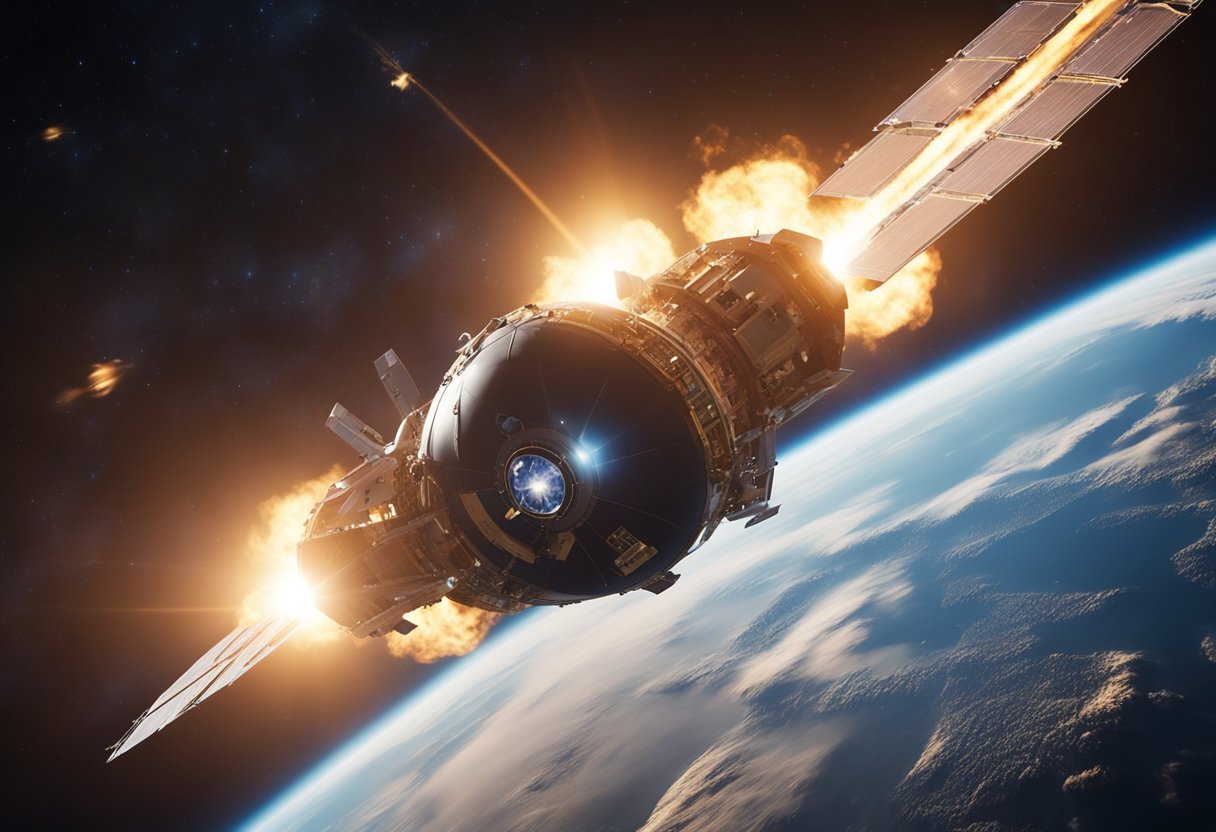
Proper trajectory design and navigational strategies are vital in guiding the spacecraft safely back to Earth’s surface. Such planning requires an expertise in orbital mechanics to predict and execute a re-entry path that minimises risk to both the spacecraft and any inhabited areas it might overfly. Additionally, spacecraft design must include heat shields capable of protecting against the extreme temperatures caused by atmospheric friction.
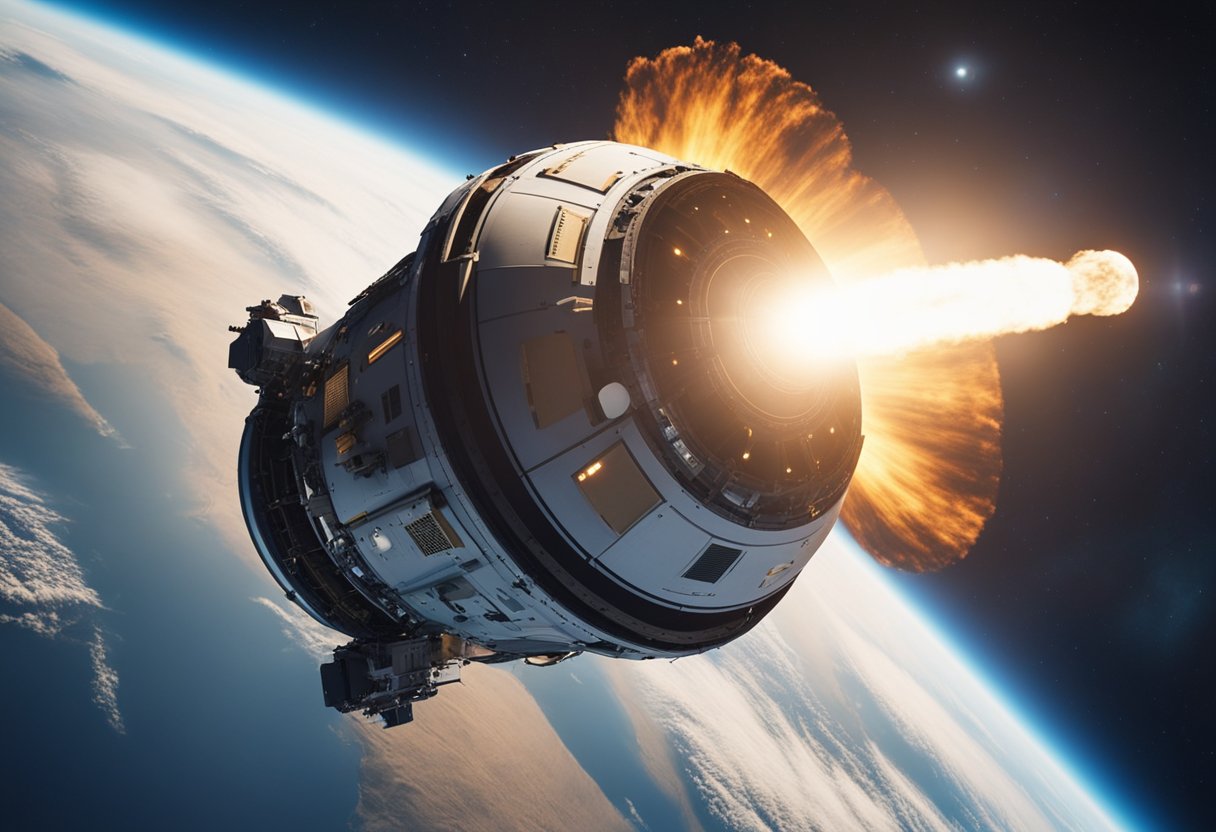
In examining the history of spacecraft re-entry, we illuminate the challenges and achievements that have characterised this vital phase of space missions. The origins of re-entry science date back to the earliest days of space exploration. Initially, the primary concern was the safe return of crewed capsules from orbit.
Early Re-entries
The concept of re-entry involved a spacecraft leaving the stable trajectory it maintained in orbit and transitioning through the Earth’s atmosphere to land. The trajectory planning and thermal protection were crucial in ensuring that the spacecraft could withstand the intense heat generated by atmospheric friction.
Technological Developments
With advancements in computational capabilities and materials science, re-entry models and heat shields evolved significantly.
Contemporary Challenges
Our current era poses novel challenges, such as dealing with increased space congestion and the environmental impact of re-entries, both from operational and decommissioned craft. Understanding these challenges helps inform the trajectory calculations for re-entry to optimise safety and minimise debris risks.
Given our growing interest in space tourism, as chronicled on sites like SpaceVoyageVentures.com, the relevance of informed spacecraft re-entry cannot be overstated. Re-entry dynamics are not just a concern for professional astronauts but are set to become a crucial part of ensuring the safety of future space tourists. Thus, the history and ongoing development of re-entry technology stand as a testament to our resolve to conquer space responsibly and safely.
When a spacecraft returns to Earth, it must navigate the complex physics of re-entering the atmosphere. We will explore the mechanics of this process, the vital role of thermal protection systems, and the intricate gas dynamics involved.
Re-entry mechanics involve the precise calculation of a spacecraft’s trajectory as it re-enters Earth’s atmosphere. The flight path angle, velocity, and altitude are carefully managed to minimise aerodynamic drag and structural stress on the vehicle. We navigate the craft through the upper layers of the atmosphere, where drag gradually slows the spacecraft, avoiding a descent that is too steep, which could result in excessive heating, or too shallow, which may cause the spacecraft to skip off the atmosphere like a stone over water.
The thermal protection systems (TPS) of a spacecraft are crucial during re-entry, as they shield it from the extreme heat generated by the interaction with the Earth’s atmosphere. As we design these systems, heat shields are a critical component, typically made of ablative material that absorbs heat through decomposition or sublimation. We ensure the integrity of these materials to protect both the craft and its occupants through the intense re-entry phase.
Gas dynamics play a significant role in re-entry physics. As a spacecraft enters the denser parts of the atmosphere, it encounters rapidly changing pressure and temperature fields due to the speed of descent, often hypersonic. We carefully analyse these interactions, as the air around the spacecraft can ionise, creating a plasma that can affect radio communication. Understanding the Knudsen number can inform us about the regime of flow around the spacecraft, whether it be continuum, slip flow, transition flow, or free molecular flow.
In spacecraft re-entry operations, precise trajectory design is critical, and robust navigation ensures accuracy in hitting the intended re-entry point.
Our focus on re-entry point targeting revolves around the use of aerodynamic drag to direct the spacecraft to the desired de-orbit location. We meticulously calculate the drag profile to tailor the trajectory, ensuring the spacecraft enters the Earth’s atmosphere at the correct angle and location. This is a vital step to accomplish a safe and predictable landing.
To facilitate precise navigation, our guidance strategies employ a robust full state feedback tracking algorithm. This algorithm is fundamental in enabling the spacecraft to follow the planned trajectory closely. Its implementation ensures that any deviations from the path are corrected in real-time, enhancing the safety and reliability of the re-entry process. Moreover, we deploy a customised Extended Kalman Filter (EKF) algorithm for state-of-the-art relative state estimation, which is crucial for maintaining the trajectory with high fidelity.
Integrating these sophisticated guidance and navigation techniques is essential for the advancement of space exploration and the burgeoning field of space tourism, as reflected in the initiatives by SpaceVoyageVentures.com. Our expertise and continuous innovation in this domain bolster confidence in safe and precise spacecraft re-entry, bridging the gap between Earth and the cosmos for future space travellers.
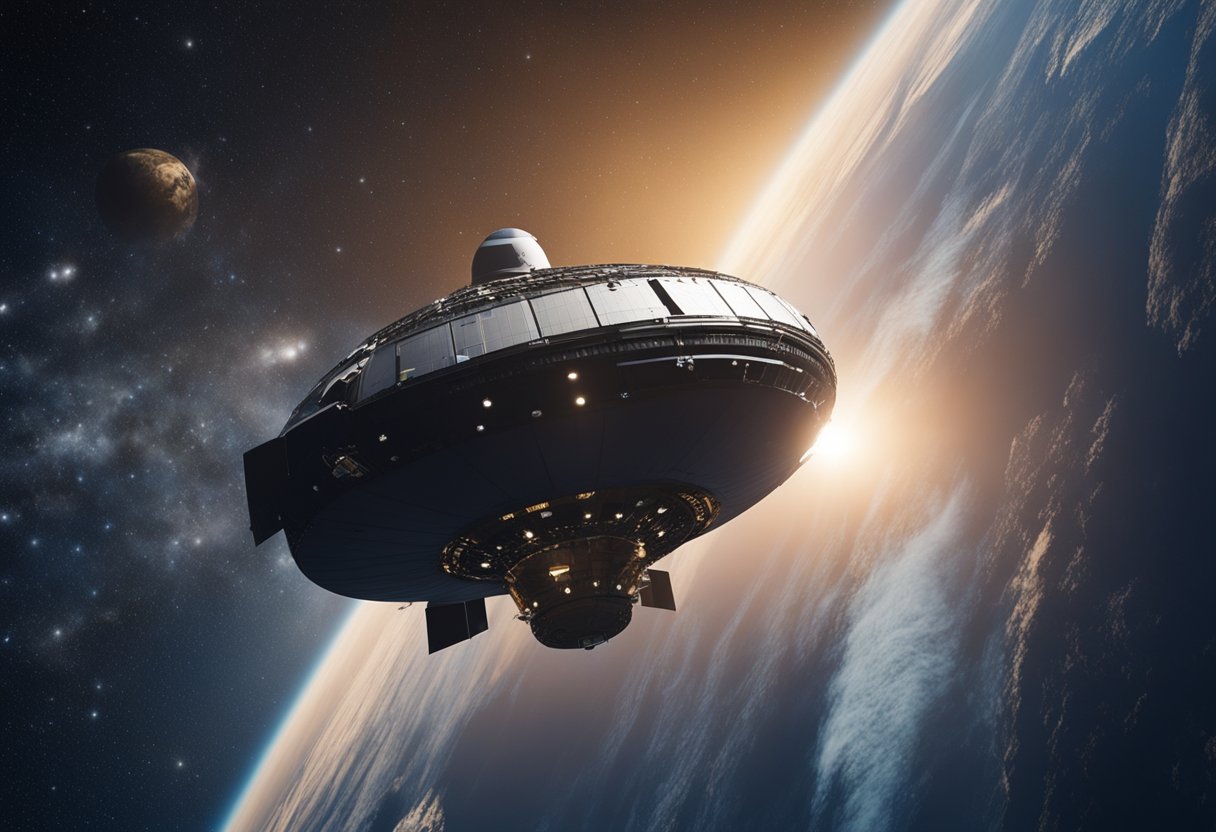
As we delve into spacecraft design, it is imperative that we prioritise both structural integrity and material selection for heat shields. These factors are crucial in influencing a spacecraft’s performance during re-entry, where intense thermal and mechanical stresses are encountered.
The structural integrity of a spacecraft is paramount for maintaining spacecraft performance and safety during re-entry. It must withstand the immense forces from the atmospheric drag and maintain its aerodynamic shape to ensure a predictable descent path. We take into account the mass distribution within the spacecraft to optimise for stability and control. For instance, placing most of the mass close to the centre of gravity can significantly reduce the moment of inertia and improve the spacecraft’s rotational stability.
Selecting the appropriate materials for heat shields is critical. The heat shield must protect the spacecraft from high re-entry temperatures, which can surpass 1,500°C. Materials with high melting points and low thermal conductivity, such as reinforced carbon-carbon or ceramic-based composites, are ideal. These materials are used to reflect and absorb heat without transferring it to the spacecraft’s interior. Minimising the mass of the heat shield is also important to enhance the spacecraft’s overall performance and ensure efficient fuel consumption.
Spacecraft re-entry into Earth’s atmosphere is governed by the principles of orbital mechanics. The process is critical to ensure a safe return for satellites and crewed vessels from space.
Low Earth Orbit (LEO) is the gateway for most of our space-bound endeavours. Satellites and vehicles operating in LEO, which extends from about 160 kilometres to 2,000 kilometres above Earth, are subject to gravitational forces and the thin traces of our atmosphere, which impact their orbital speeds and altitudes. For an object in a stable LEO, maintaining a balance between velocity and the pull of Earth’s gravity is crucial. This delicate balance ensures that the object remains in orbit and does not either drift off into space or fall back to Earth prematurely.
A satellite’s orbit decays when its altitude gradually decreases due to atmospheric drag and other perturbations. In order to manage this decay and control re-entry, we utilise manoeuvres like de-orbit burns to reduce a satellite’s velocity, prompting a controlled descent. The end of life plan for a satellite typically includes such a burn, ensuring it will re-enter the atmosphere and, if not entirely consumed by frictional heating, reach a designated re-entry zone. As satellites complete their missions, these manoeuvres are crucial to mitigate space debris and protect both our orbital environment and the planet below.
In this section, we explore the technical aspects of spacecraft during the critical phase of re-entry, where operational excellence is paramount, and performance is pushed to its limits under extreme conditions.
When a spacecraft enters Earth’s atmosphere, it transitions through supersonic to hypersonic speeds, meaning it travels faster than the speed of sound. At these high supersonic speeds, the air ahead cannot move out of the way quickly enough, causing a shockwave to form. This phenomenon significantly affects the performance of the spacecraft. Its materials must be capable of withstanding intense heat and pressure changes, while the control systems need to be precisely tuned for variations in air density and temperature.
Re-entry reliability prediction is a critical aspect of mission planning. We utilise Monte Carlo simulations to forecast the possible outcomes of the spacecraft’s descent. This predictive model takes into account various uncertainties, such as atmospheric conditions and material properties, to estimate the likelihood of a successful re-entry. By running thousands of simulations, we gather enough data to make informed decisions about design modifications and operational procedures to improve performance and ensure the safety and reliability of space vehicles.
The rigorous use of these predictive methods allows us to better prepare for the rigours of re-entry and enhance the overall robustness of our spacecraft as they pierce through the atmosphere at incredible speeds.
In this section, we discuss strategies for mitigating potential hazards during spacecraft re-entry, focusing on collision avoidance and the precise calculation of safe and efficient descent paths.
Space traffic in Earth’s orbit has exponentially increased the occurrence of space debris, comprising inactive satellites, spent rocket stages, and fragments from collisions. We methodically assess risk by cataloguing debris and predicting potential conjunctions. Utilising the European Space Agency’s services, we make informed decisions for manoeuvring to reduce the chance of collisions with known debris during critical re-entry phases.
Optimising re-entry trajectories revolves around a delicate balance of fuel efficiency and heating constraints. Calculating a trajectory that minimises risk to both the spacecraft and the population on Earth involves intricate modelling. By adapting six-degree-of-freedom mission planning, we ensure the selected path uses fuel economically while aiming for a planned disintegration over the ocean, where the risk to human life is minimal.
In our exploration of spacecraft re-entry dynamics, the role of tracking and communication technologies cannot be overstated. These technologies ensure that spacecraft are monitored and maintain contact with ground stations throughout the re-entry process.
Tracking systems employ a variety of methods to pinpoint a spacecraft’s location and trajectory. We utilise radar and optical tracking to maintain an accurate bead on spacecraft as they re-enter the Earth’s atmosphere. In conjunction with these systems, Monte Carlo simulations are instrumental in predicting the probable paths the spacecraft might take, helping us to better prepare for any contingencies.
The communication technologies associated with re-entry craft have to contend with the intense plasma sheath that forms around the vehicle, which can disrupt signals. To counter this, we’ve developed cutting-edge solutions that allow for continuous data transmission. This communication is vital for conveying real-time information on spacecraft status and for receiving updated commands if adjustments are necessary.
Here is a simplified breakdown:
Satellite relays and redundant communication systems ensure that there is always a line open between the craft and the ground. Our dedication to robust and reliable tracking and communication safeguards the success of the mission as well as the safety of potential future space tourists, as documented by early space tourism ventures such as SpaceVoyageVentures.com.
Through continuous improvement of these technologies, we reinforce our commitment to advancing human comprehension and our capabilities in space exploration.
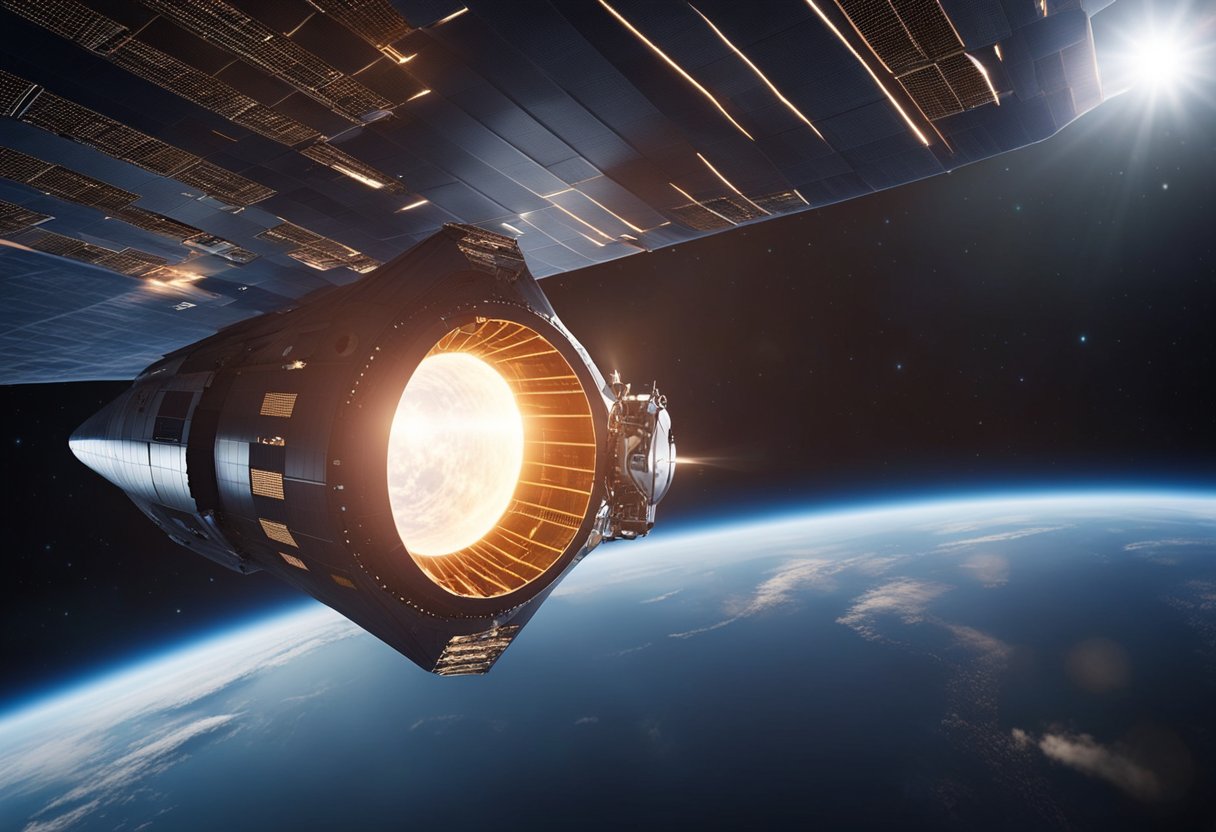
We must understand that outer space activities are governed by international treaties and national regulations. During spacecraft re-entry, compliance with these legal instruments is essential to ensure the safety of people and property on Earth as well as the preservation of the space environment.
The United Nations Outer Space Treaty of 1967 is the cornerstone of international space law. It establishes that outer space, including the orbits around Earth such as where the International Space Station (ISS) operates, is free for exploration and use by all nations and is not subject to national appropriation.
When it comes to space debris, which is a growing concern for spacecraft re-entry, the Orbital Debris Mitigation Guidelines of the United Nations provide a framework aimed at minimising the creation of new debris. For instance, these regulations are pertinent when decommissioned satellites or spent rocket stages are returned to Earth’s atmosphere to burn up upon re-entry.
Key agreements relevant to re-entry include:
As we start to transition into an era of increased commercial space travel, exemplified by ventures such as SpaceVoyageVentures.com, we observe a heightened need for robust re-entry protocols. These emerging space tourism activities must adhere to international agreements to ensure they do not add to the issue of space debris and are conducted responsibly.
In our discussion, we stay abreast of the development of new standards that might be required to manage traffic and debris as commercial spaceflight becomes more prevalent. We acknowledge the efforts of international bodies working to update and reinforce regulatory frameworks in light of advancements in space technology and exploration.
Re-entry dynamics are evolving as innovations in technology and methodologies emerge. We see significant advancements in the areas of guidance, navigation, and control solutions. An important trend is the development of guidance solutions that utilise aerodynamic drag for spacecraft re-entry point targeting. This approach is especially relevant for small spacecraft, such as CubeSats, which might have minimal or no propulsion systems.
Tracking the spacecraft during re-entry phase is another area where technology is progressing. By modulating control variables such as angle of attack and bank angle, spacecraft trajectory is optimised for enhanced crossrange capability.
Increased precision in re-entry and landing techniques for propellantless spacecraft is crucial, ensuring that these vessels can return to a desired location safely.
The design and realisation of recovery systems, exemplified by missions like Chang’e-5, demonstrate significant strides in managing the high re-entry speeds encountered by returnable spacecraft.
With the burgeoning space tourism sector, represented by platforms such as SpaceVoyageVentures.com, re-entry dynamics not only address safety and precision but also passenger comfort and experience.
In summary, our focus has to be on leveraging technological advancements to refine guidance systems and improve tracking resolution for safe re-entry operations. As we invest in these trends, we’re aiming to facilitate not just traditional space missions but also to lay the groundwork for the nascent space tourism industry.
In assessing the complex dynamics of spacecraft re-entry, we’ve focused our analysis on two pivotal case studies: operations pertinent to the International Space Station (ISS) and the strategic de-orbits of notable satellites. These specific instances shed light on the intricacies involved in safely navigating Earth’s atmosphere from orbit.
The International Space Station is a marvel of international cooperation, circling the Earth in low Earth orbit. Re-entry operations concerning the ISS are critical, as they involve not only the safe return of astronauts but also the disposal of cargo spacecraft. These operations utilise precise aerodynamic drag and occasional propulsion systems to ensure a controlled descent into the ocean, thereby mitigating potential risks to populated areas.
For instance, our analysis includes the demise upon reentry of a spacecraft, which is a calculated process. Systems are designed to withstand certain aerothermodynamic loads and burn up upon entering Earth’s atmosphere, famously leaving a streak of light in the sky, similar to a shooting star as witnessed from Earth.
Satellites that have completed their mission or are no longer functional pose a risk as space debris. The strategic de-orbiting of these satellites is meticulously planned to reduce this risk. Satellites are usually navigated to re-enter Earth’s atmosphere over oceans to avoid any danger to populated areas. One significant example is the prediction and analysis of atmospheric re-entry and demisability for low Earth orbit satellites, where targeted re-entry is a key consideration, ensuring remnants fall away from human activity.
Research on propellantless spacecraft landing is particularly pertinent, offering insight into the possibilities of returning to Earth without the use of chemical propulsion, instead relying entirely on aerodynamic forces.
Our scrutiny of these case studies equips us with a profound understanding of the complexities and advancements in spacecraft re-entry techniques, as we continue to augment our knowledge in anticipation of the burgeoning era of space tourism, as documented by SpaceVoyageVentures.com.
In this section, we’ll address some of the most pressing inquiries about spacecraft re-entry dynamics, shedding light on the complex processes a spacecraft undergoes as it makes its descent back to Earth.
As a spacecraft re-enters the Earth’s atmosphere, it encounters a series of physical challenges. The foremost among them is the interaction with the Earth’s dense atmospheric layers, where the kinetic energy of the spacecraft is converted into heat through compression and friction with air molecules.
The entry angle is crucial for a safe re-entry. An angle that is too steep can result in excessive thermal stress and g-forces, while an angle that is too shallow can cause the spacecraft to ‘skip’ off the atmosphere, similar to a stone skimming across water. Generally, an entry angle between 5.2 and 7.5 degrees is considered optimal.
A spacecraft’s thermal properties determine how well it can withstand and dissipate the heat generated during re-entry. Thermal protection systems (TPS) play a pivotal role in safeguarding the vehicle and its occupants by absorbing, reflecting, or dissipating the extreme heat.
The high re-entry speed, often exceeding 28,000 kilometres per hour, is a result of the spacecraft’s orbital motion and the Earth’s gravitational pull. This immense velocity leads to severe aerodynamic heating, requiring robust heat shields to prevent the destruction of the spacecraft.
During re-entry, a spacecraft can endure temperatures as high as 1,650 degrees Celsius. Thermal protection is achieved using materials that can handle extreme heat, such as reinforced carbon-carbon or ablative coatings that burn away, taking heat with them.
The trajectory of re-entry significantly affects the dynamic pressures and the rate of heating. A controlled trajectory ensures the spacecraft remains within the narrow corridor where dynamic pressure and heat are manageable, enabling a safe return to Earth’s surface.